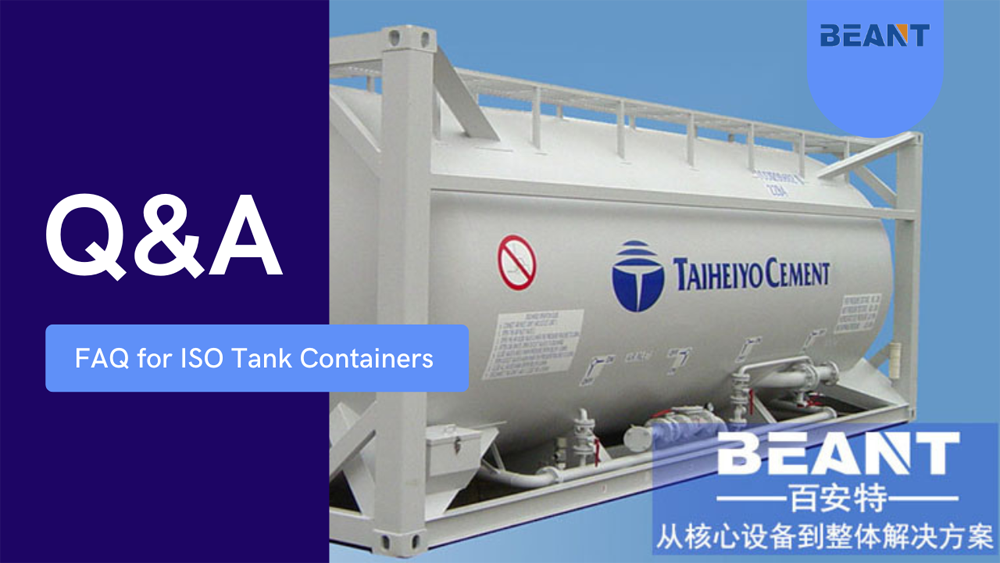
ISO tank containers are specialized containers designed for the safe, efficient, and reliable transportation of bulk liquids, gases, and powders. These containers are built according to the standards set by the International Organization for Standardization (ISO), ensuring uniformity and compatibility in the global shipping and logistics industry. ISO tank containers are crucial for various industries, including chemicals, food and beverage, pharmaceuticals, and petroleum, due to their versatility and efficiency.
ISO tank containers are intermodal containers made from stainless steel with an insulation and protective layer of aluminum or polyurethane. They are designed to carry bulk liquids, powders, and gases. These containers come in different configurations, including lined, unlined, and insulated versions, catering to the specific needs of various industries.
ISO tank containers typically come in two standard sizes: 20 feet and 40 feet in length. The standard 20-foot tank container has a capacity ranging from 20,000 to 26,000 liters, while the 40-foot version can hold up to 46,000 liters. The specific dimensions and capacity can vary slightly depending on the manufacturer and the intended use of the container. The standardized dimensions allow these containers to be easily transported by road, rail, and sea, fitting seamlessly into the existing logistics infrastructure.
The primary material used in the construction of ISO tank containers is stainless steel, due to its durability, resistance to corrosion, and ease of cleaning. The tank is typically housed within a frame made from carbon steel or aluminum. Insulating materials such as polyurethane foam or aluminum may be used for containers designed to transport temperature-sensitive goods. The choice of materials ensures that the containers can withstand the rigors of transportation and protect the cargo from contamination and environmental factors.
Maintaining ISO tank containers involves regular inspections, cleaning, and repairs to ensure their safety and integrity. Inspections are typically conducted before and after each use to check for any signs of damage, wear, or contamination. Cleaning protocols depend on the type of cargo previously transported; for instance, food-grade tanks require thorough cleaning to meet hygiene standards, while chemical tanks may require specialized cleaning agents to remove residues. Regular maintenance also includes checking and replacing gaskets, valves, and other fittings to prevent leaks and ensure proper functioning.
Yes, ISO tank containers are designed with numerous safety features to transport hazardous materials safely. These containers must comply with international regulations such as the International Maritime Dangerous Goods (IMDG) Code, the International Convention for the Safety of Life at Sea (SOLAS), and the International Atomic Energy Agency (IAEA) regulations for transporting radioactive materials. Safety features include pressure relief valves, spill containment systems, and robust construction materials that minimize the risk of leaks and spills. Additionally, operators must undergo specialized training to handle and transport hazardous materials safely.
ISO tank containers are designed for intermodal transportation, meaning they can be easily transferred between different modes of transport, such as road, rail, and sea. When transported by road, these containers are mounted on specialized chassis or trailers. For rail transport, they are securely fastened onto flatbed railcars. In maritime shipping, ISO tank containers are stacked and secured on container ships. Proper handling and securing procedures are essential to prevent movement during transit, which can lead to spills, leaks, or damage to the container and its contents.
ISO tank containers offer several advantages over other container types, including:
Efficiency: Their standardized dimensions allow for seamless intermodal transport, reducing handling time and costs.
Safety: Robust construction and safety features make them suitable for transporting hazardous materials.
Versatility: They can carry a wide range of liquids, gases, and powders, making them useful for various industries.
Environmental Impact: ISO tank containers are reusable and have a longer lifespan compared to single-use containers, reducing waste and environmental footprint.
ISO tank containers must comply with various international regulations to ensure safety and compatibility across different transport modes and regions. Key regulations include:
International Maritime Dangerous Goods (IMDG) Code: Governs the transport of dangerous goods by sea.
International Convention for the Safety of Life at Sea (SOLAS): Ensures safe shipping practices.
International Tank Container Organization (ITCO) Standards: Provides guidelines for the design, manufacture, and operation of tank containers.
International Organization for Standardization (ISO) Standards: Defines the specifications and dimensions for tank containers. Compliance with these regulations ensures that ISO tank containers meet safety, environmental, and performance standards globally.
Yes, ISO tank containers can be customized to meet specific requirements of different industries and cargo types. Common customization options include:
Insulation and Heating Systems: For temperature-sensitive cargo.
Specialized Linings: For corrosive or reactive chemicals.
Additional Safety Features: Such as extra valves, gauges, and pressure relief systems.
Capacity Adjustments: Tailoring the size and capacity to specific needs. Customization enhances the versatility and utility of ISO tank containers, ensuring they can safely and efficiently transport a wide range of products.
The lifespan of an ISO tank container can vary depending on factors such as usage, maintenance, and the type of cargo transported. On average, a well-maintained ISO tank container can last between 20 to 30 years. Factors that can extend the lifespan include regular maintenance, proper handling, and timely repairs. Conversely, transporting aggressive or corrosive chemicals without adequate cleaning and maintenance can shorten the container’s lifespan.
Choosing the right ISO tank container depends on several factors, including:
Type of Cargo: Different cargoes require specific tank features, such as linings for corrosive chemicals or insulation for temperature-sensitive goods.
Capacity Requirements: Determine the volume of cargo to be transported to select the appropriate tank size.
Regulatory Compliance: Ensure the container meets all relevant regulations for the intended cargo and transport modes.
Customization Needs: Consider any special features or modifications required for your specific use case.
Cost: Balance initial costs with long-term benefits such as durability and efficiency. Consulting with manufacturers and industry experts can help you make an informed decision tailored to your specific needs.
ISO tank containers play a vital role in global logistics and transportation, offering a safe, efficient, and versatile solution for transporting a wide range of bulk liquids, gases, and powders. Understanding the key aspects of ISO tank containers, including their construction, maintenance, safety features, and regulatory requirements, is essential for optimizing their use and ensuring the safe and efficient transport of goods. By choosing the right ISO tank container and adhering to best practices, businesses can enhance their operational efficiency and contribute to safer, more sustainable global trade.
Feel free to leave your message on our board. If you're looking to inquire about prices or place an order, this is the right place! Let us know the details of your needs, and our team will get back to you with a personalized quote as quickly as possible. We're here to ensure your experience is seamless and satisfactory. Share your requirements or ask any questions you might have - we're eager to assist and look forward to doing business with you!
Name:Tim
Phone:+86-15716151880
Email:[email protected]
Company:BEANT
Address:No. 28, Luoshen Road, Luoshe Town, Huishan District, Wuxi City, Jiangsu Province
